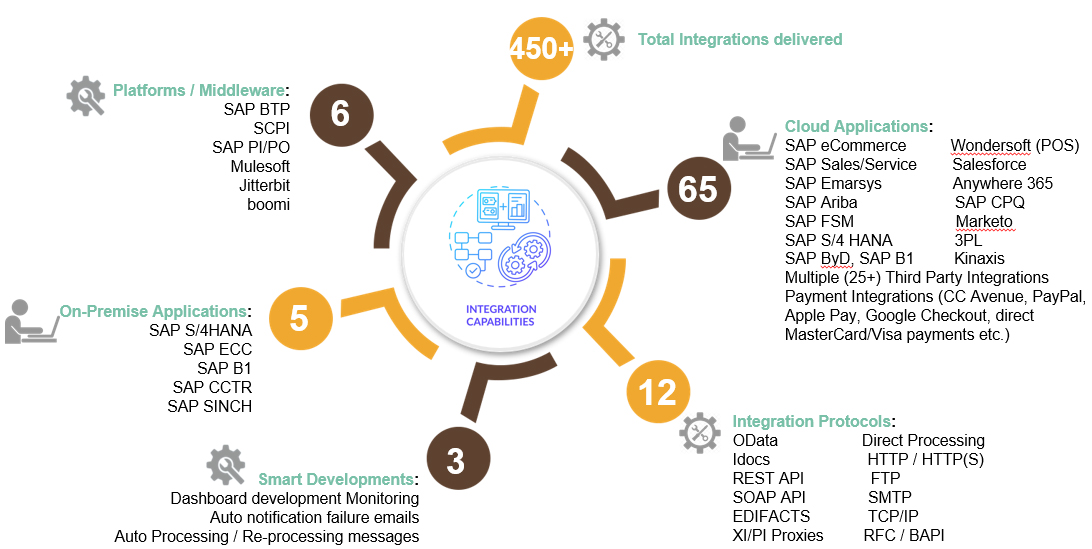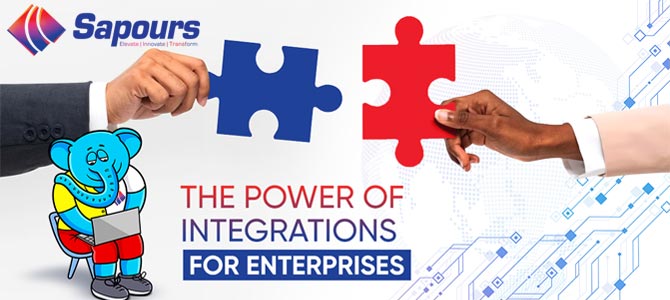Imagine a disgruntled customer calling your customer service center to complain. The customer service agent puts the customer on hold and toggles between various applications to retrieve the customer’s data and solve the query. By the time the agent solves the problem, the customer loses trust in your services and decides to go to your competitor or post about it on social media.
Sounds familiar?
Well, that happens when enterprises use multiple disparate systems to do business.
While enterprises aim to become connected and omnichannel, the lack of integration between various systems makes it hard for enterprises to provide a seamless experience to customers.
Real-time cohesive data is necessary for enterprises to make timely and informed decisions.
It’s crucial that enterprises invest in system integrations.
What Are Integrations and Why Are They Important?
System Integration involves a combination of different and disparate systems. Each system performs a specific action and serves a different goal. Each of them collects and stores data. Integration brings these systems together to ensure smooth data flow and provide a 360-degree centralized view to decision-makers.
Integrations can help enterprises in:
- Improving productivity
According to a study conducted on a Fortune 500 Consumer Goods company, each employee switched between 22 different applications and websites about 350 times. On an average day, each employee would toggle between apps 3,600 times! This swivel chair approach consumes employees’ time and impacts their productivity. They are left with little time to do high-value tasks.
Since integration combines all the applications together, the data flows seamlessly into a centralized application. This reduces the toggling between apps and saves their time.
- Accelerating decision-making
Fragmented data doesn’t provide a holistic picture to decision-makers. By the time they fully understand the data, it’s too late to make any decision. In a fast-paced business environment, enterprises must make quick decisions to meet customer needs.
Integrations ensure that the decision-makers can access all the data in one place. They get a holistic understanding of the data, which enables them to make informed and accurate decisions quickly.
- Democratizing data access
Gone are the days when data was accessible to only a handful of employees. Enterprises have to democratize data access as the focus shifts to making fast data-driven decisions.
Since integrations unify all the data in one place, authorized employees can access them easily anytime without depending on anybody. Integration also syncs the data across all the systems automatically. This helps the employees receive updated information for decision-making.
- Reducing costs
Since all the systems are integrated, enterprises don’t have to spend too much on maintaining the systems. They also don’t have to manage multiple data storages, drastically reducing costs.
Challenges in Integrating Systems
- Increasing complexities
Most systems are dynamic and update frequently to meet market changes. While integration synchronizes data across all systems, enterprises can face difficulties managing the complexities arising from the frequent updates. It becomes even more complicated when more systems are introduced to the ecosystem. Enterprises must be agile and respond quickly to updates and new systems to ensure decision-makers receive updated and accurate information.
- Legacy systems
Many enterprises still rely on legacy systems for their daily operations. Since these systems are not designed for integration, enterprises struggle to integrate them. Enterprises upgrading their technologies must ensure they are integrated with other applications and systems in the ecosystem.
- Lack of resources and skilled tools
System Integration requires deep knowledge of different systems and programming. A shortage of skilled resources can make it hard for enterprises to integrate various systems and ensure smooth data flow. The proper integration tool is vital as enterprises deal with legacy and modern applications stored across the cloud and on-premise environments. Without that, enterprises cannot achieve their goals.
Integration Technologies You Need for Successful Integration
To build interoperable system integration, enterprises must focus on protocols, domain integrations, and middleware.
- Protocols
Data protocols are specific implementations required to ensure smooth data exchange between different systems and applications. These guidelines guide enterprises in requesting, delivering, and processing data across different endpoints. Common protocols include Simple Object Access Protocol (SOAP), Representational State Transfers (REST), Hypertext Transfer Protocol (HTTP), and Application Programming Interfaces (API). These protocols help integrate data across various applications, software, and distributed systems. They manage data security, integrity, and reliability across networks and channels.
- Domain Integrations
Domain integration helps in aligning and harmonizing different domains across different platforms. This can be done using Virtual Private Network (VPN), Single Sign-On (SSO), or Identity and Access Management (IAM). As more enterprises transition from pure on-premise to hybrid or pure-cloud environments, domain integration ensures seamless integration of the platforms.
- Middleware
Middleware (such as SAP Integration suite formerly known as SCPI (SAP Cloud Platform Integration), Mulesoft, etc) acts as a glue or an intermediary layer between various applications and software. It is also called plumbing because it connects both sides of an application and facilitates seamless communication and data transfer between applications and systems. Typically, middleware is a mediator between the frontend and backend resources.
However, it has now grown in scope. It ensures the integrations are working fine. Now, middleware is classified into domains based on the types of resources utilized. For example, in cloud integration, a middleware integrates with and between cloud services, applications, and resources using web services, File Transfer Protocol (FTP), or Applicability Statement 2 (AS2).
There are various types of Middleware that serve specific purposes. For example, a database middleware is a form of SQL that provides access to the backend database, and an API middleware can be an API gateway or developer portal that allows developers to create and manage APIs for applications.
Middleware simplifies application development by supporting various integrations across different domains and speeds up the time-to-market
How To Integrate Systems?
We now know why integrations between different systems and applications are essential to provide customers with a connected and omnichannel experience. We also know the types of integration technologies required for successful integration.
However, technology alone cannot guarantee success. Enterprises must work with a partner who understands their business needs and has the capabilities to integrate complex applications and systems across different environments.
At Sapours, we’ve delivered 450+ integrations to our clients. Here’s a sneak peek of the integrations we’ve built till now.

As SAP and Salesforce partners, we combine our technological prowess, experience, and expertise to integrate the most complex systems and build seamless experiences for our clients.
To know more about how we can help with integration, contact us.

